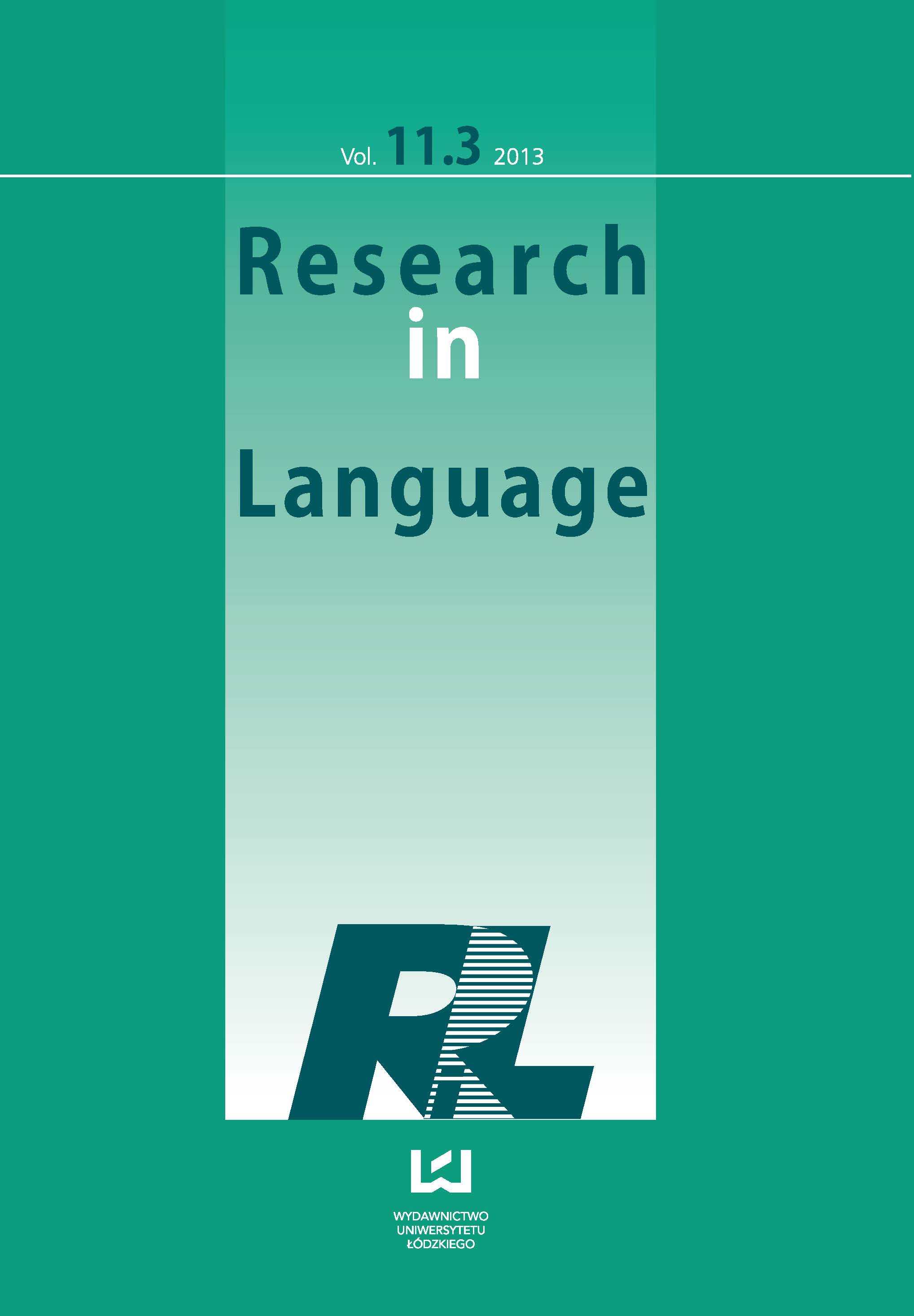Like in Similes – A Relevance-Theoretic View
DOI:
https://doi.org/10.2478/v10015-012-0015-7Abstract
The paper examines the meaning of like as used in similes in the light of relevance theory. Similes, even though superficially indistinguishable from literal comparisons, are found to be closer to metaphors. Therefore, it is proposed that like in similes is different from like employed in literal comparisons. In particular, it is claimed that, contrary to the current relevance-theoretic position on this issue, like in similes introduces an ad hoc concept. This like is seen as both conceptual and procedural and, as such, it is distinct from both the conceptual like used in literal comparisons and the procedural like functioning as a pragmatic marker. Such a solution accounts for the similarities and differences between similes, metaphors and literal comparisons.
References
Andersen, Gisle (2001). Pragmatic markers and sociolinguistic variation: A relevancetheoretic approach to the language of adolescents. Amsterdam & Philadelphia: John Benjamins.
Google Scholar
Aristotle (2007). In G. A. Kennedy (Ed.), Aristotle on Rhetoric: A theory of civic discourse. (2nd ed.). New York & Oxford: Oxford University Press.
Google Scholar
Beardsley, Monroe C. (1981). Aesthetics: Problems in the philosophy of criticism. (2nd ed.). Indianapolis, IN: Hackett.
Google Scholar
Blakemore, Diane (1987). Semantic constraints on relevance. Oxford: Blackwell.
Google Scholar
Blakemore, Diane (2002). Relevance and linguistic meaning. The semantics and pragmatics of discourse markers. Cambridge: Cambridge University Press.
Google Scholar
Bordería, Salvador Pons (2008). “Do discourse markers exist? On the treatment of discourse markers in relevance theory”. Journal of Pragmatics, 40, 1411-1434.
Google Scholar
Bredin, Hugh (1998). “Comparisons and similes”. Lingua, 105, 67-78.
Google Scholar
Carston, Robyn (2002). Thoughts and utterances. Oxford: Blackwell.
Google Scholar
Carston, Robyn (2010). “Explicit communication and ‘free’ pragmatic enrichment”. In B. Soria & E. Romero (Eds.), Explicit communication: Robyn Carston’s pragmatics (217-285). Houndmills, Basingstoke: Palgrave Macmillan.
Google Scholar
Croft, William & D. Alan Cruse (2004). Cognitive linguistics. Cambridge: Cambridge University Press.
Google Scholar
Cruse, D. Alan (2006). A glossary of semantics and pragmatics. Edinburgh: Edinburgh University Press.
Google Scholar
Feder Kittay, Eva (1987). Metaphor: Its cognitive force and linguistic structure. Oxford: Clarendon Press.
Google Scholar
Glucksberg, Sam (2001). Understanding figurative language. Oxford: Oxford University Press.
Google Scholar
Glucksberg, Sam (2008). “How metaphors create categories – quickly”. In R. Gibbs (Ed.), The Cambridge handbook of metaphor and thought (67-83). Cambridge: Cambridge University Press.
Google Scholar
Glucksberg, Sam & Catrinel Haught (2006), “On the relation between metaphor and simile: When comparison fails”. Mind & Language, 21, 360-378.
Google Scholar
Glucksberg, Sam & Boaz Keysar (1993). “How metaphors work”. In A. Ortony (Ed.), Metaphor and thought (401-424). (2nd ed.). Cambridge: Cambridge University Press.
Google Scholar
Hernández Iglesias, Manuel (2010). “Ad hoc concepts and metaphor”. In B. Soria & E. Romero (Eds.), Explicit communication: Robyn Carston’s pragmatics (173-182). Houndmills, Basingstoke: Palgrave Macmillan.
Google Scholar
Israel, Michael, Jennifer Riddle Harding & Vera Tobin (2004). “On simile”. In M. Achard & S. Kemmer (Eds.), Language, culture, and mind (123-135). Stanford: CSLI Publications.
Google Scholar
Lakoff, George & Mark Turner (1989). More than cool reason: A field guide to poetic metaphor. Chicago: University of Chicago Press.
Google Scholar
Leezenberg, Michiel (2001). Contexts of metaphor. Amsterdam: Elsevier.
Google Scholar
Levinson, Stephen (1983). Pragmatics. Cambridge: Cambridge University Press.
Google Scholar
Margolis, Joseph (1957). “Notes on the logic of simile, metaphor and analogy”. American Speech, 32, 186-189.
Google Scholar
Miller, George (1993). “Images and models, similes and metaphors”. In A. Ortony (Ed.), Metaphor and thought (357-400). (2nd ed.). Cambridge: Cambridge University Press.
Google Scholar
Moeschler, Jacques (2002). “Connecteurs, encodage conceptuel et encodage procédural”. Cahiers de Linguistique Française, 24, 265-292.
Google Scholar
O’Donoghue, Josie (2009). “Is a metaphor (like) a simile? Differences in meaning, effect and processing”. UCL Working Papers in Linguistics, 21, 125-149.
Google Scholar
Ortony, Andrew (1993). “The role of similarity in similes and metaphors”. In A. Ortony (Ed.), Metaphor and thought (342-356). (2nd ed.). Cambridge: Cambridge University Press.
Google Scholar
Ricoeur, Paul (2003). The rule of metaphor. The creation of meaning in language. Trans. by R. Czerny with K. McLaughlin & J. Costello. London & New York: Routledge.
Google Scholar
Takeuchi, Michiko (1997). “Conceptual and procedural encoding: cause-consequence conjunctive particles in Japanese”. UCL Working Papers in Linguistics, 9, 1-24.
Google Scholar
Vega Moreno, Rosa E. (2007). Creativity and convention. The pragmatics of everyday figurative speech. Amsterdam & Philadelphia: John Benjamins.
Google Scholar
Wałaszewska, Ewa (2010). “Simile in relevance theory: Towards an alternative account”. Acta Philologica, 38, 13-19.
Google Scholar
Wilson, Deirdre & Robyn Carston (2007). “A unitary approach to lexical pragmatics: Relevance, inference and ad hoc concepts”. In N. Burton-Roberts (Ed.), Pragmatics (230-259). Houndmills, Basingstoke: Palgrave Macmillan.
Google Scholar
Wilson, Deirdre & Dan Sperber (1993). “Linguistic form and relevance”. Lingua, 90, 1- 25.
Google Scholar
Xu, Xu (2010). “Interpreting metaphorical statements”. Journal of Pragmatics, 42, 1622-1636.
Google Scholar
Downloads
Published
How to Cite
Issue
Section
License

This work is licensed under a Creative Commons Attribution-NonCommercial-NoDerivatives 4.0 International License.










